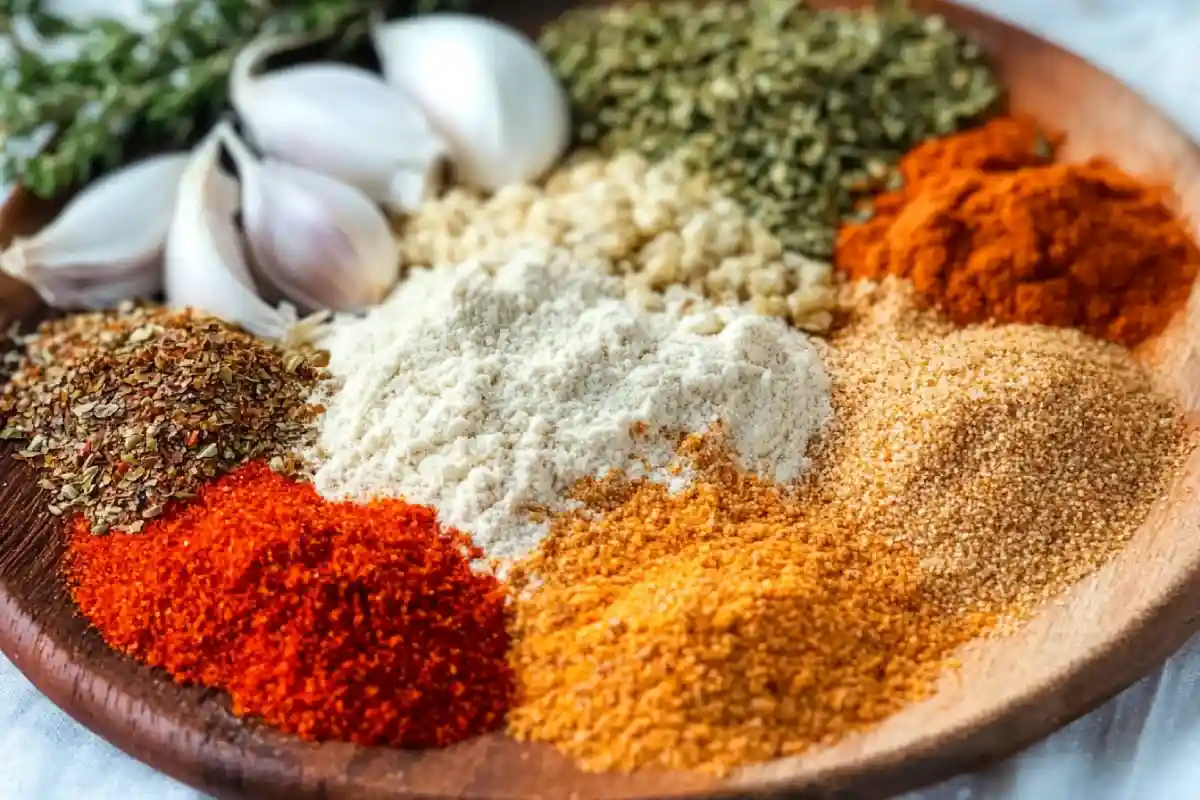
Table of Contents
I perfected this jambalaya seasoning mix after five blind-taste tests of store blends and homemade ratios—landing on a 4 : 2 : 1 : 1 mix of smoked paprika, garlic powder, onion powder, cayenne, plus dried oregano and thyme. In under two minutes you’ll whisk pantry spices into a blend that transforms rice, beans, or stews with authentic Cajun heat and aroma.
What Is Jambalaya Seasoning Mix?
A jambalaya seasoning mix is a flavorful blend of spices that captures the essence of Louisiana’s rich culinary heritage. This mix is essential for creating authentic jambalaya, a dish that combines rice with a variety of meats and vegetables. The seasoning not only imparts depth and heat but also brings together the diverse flavors that define Cajun and Creole cuisines.
Key Components of Jambalaya Seasoning Mix
The traditional jambalaya seasoning mix typically includes:
- Paprika (often smoked)
- Garlic powder
- Onion powder
- Dried oregano
- Dried thyme
- Cayenne pepper
- Black pepper
- White pepper
- Salt
These ingredients work in harmony to create a balance of smoky, spicy, and savory flavors. Notably, the inclusion of both black and white pepper adds complexity, while herbs like oregano and thyme contribute to the aromatic profile.
Cajun vs. Creole: Understanding the Differences
While both Cajun and Creole cuisines utilize similar spices, their seasoning blends have distinct characteristics:
- Cajun seasoning is generally spicier, emphasizing bold heat and intense, robust flavors.
- Creole Seasoning: Incorporates a wider array of herbs, offering a more nuanced taste.
Understanding these differences is crucial when selecting or preparing a jambalaya seasoning mix, as it influences the overall flavor of the dish.
Versatility Beyond Jambalaya
The jambalaya seasoning mix isn’t limited to just jambalaya. Its robust flavor profile makes it suitable for various dishes, including:
- Gumbo spice mix
- Creole seasoning for gumbo
- Homemade jambalaya seasoning for grilled meats or roasted vegetables
By incorporating this mix into different recipes, you can infuse them with the distinctive taste of Louisiana cuisine.
Crafting Your Own Blend
Creating a homemade jambalaya seasoning mix allows for customization to suit personal taste preferences. Adjusting the levels of heat or herbaceousness can result in a blend that’s uniquely yours. For a detailed guide on crafting your own Creole seasoning, consider exploring this Creole Seasoning Blend Recipe.
Enhancing Your Culinary Creations
Incorporating a well-balanced jambalaya seasoning mix can elevate your cooking, bringing the vibrant flavors of Louisiana to your kitchen. Whether you’re preparing traditional jambalaya or experimenting with new recipes, this seasoning mix serves as a versatile and essential component in your culinary toolkit.
Homemade Jambalaya Seasoning Recipe
Creating your own jambalaya seasoning mix at home is both simple and rewarding. Not only does it allow you to tailor the flavors to your preference, but it also ensures the freshness of each ingredient. Moreover, having a homemade blend on hand can elevate a variety of dishes, bringing the authentic taste of Louisiana right to your kitchen.
Essential Ingredients
To craft a balanced and flavorful jambalaya seasoning mix, gather the following spices:
- 2 tablespoons paprika (smoked paprika adds depth)
- 1 tablespoon garlic powder
- 1 tablespoon onion powder
- 1 tablespoon dried oregano
- 1 tablespoon dried thyme
- 1 teaspoon cayenne pepper (adjust to taste)
- 1 teaspoon black pepper
- 1 teaspoon white pepper
- 1 tablespoon salt
These ingredients combine to deliver the signature smoky, spicy, and herbal notes characteristic of traditional jambalaya.
Preparation Steps
- Measure each spice accurately to maintain the intended flavor balance.
- Combine all the spices in a mixing bowl, ensuring they are thoroughly blended.
- Transfer the mixture into an airtight container, such as a glass jar with a tight-fitting lid.
- Store the seasoning in a cool, dark place to preserve its potency.
By following these steps, you’ll have a ready-to-use jambalaya seasoning mix that can enhance a variety of dishes beyond jambalaya, including grilled meats, roasted vegetables, and soups.
Storage Tips
Proper storage is crucial to maintain the freshness and flavor of your homemade seasoning. Keep the mix in an airtight container away from heat and light sources. Under optimal conditions, the seasoning should retain its quality for up to six months. Always use a dry spoon when scooping out the mix to prevent moisture from entering the container.
Internal Linking Opportunity
For more ways to use your homemade blend, explore other flavorful recipes on our Louisiana dishes collection. You’ll discover dishes that perfectly complement the bold profile of this jambalaya seasoning mix.
Cajun Jambalaya Seasoning vs. Creole Seasoning for Gumbo
When diving into Southern cuisine, it’s crucial to understand the distinctions between Cajun and Creole seasonings. Both styles contribute unique flavors to dishes like jambalaya and gumbo, and knowing their distinctions can enhance your culinary creations.
Cajun Seasoning: Bold and Rustic
Cajun seasoning is recognized for its bold, spicy flavor profile that brings heat and depth to dishes. Typically, it includes:
- Paprika
- Cayenne pepper
- Black pepper
- Garlic powder
- Onion powder
- Salt
This blend is often used in dishes that aim for a hearty and fiery flavor. In Cajun jambalaya, the absence of tomatoes results in a darker, more intense dish.
Creole Seasoning: Herbaceous and Complex
In contrast, Creole seasoning delivers a more delicate, herbaceous flavor with a balanced blend of spices and herbs. Common ingredients include:
- Thyme
- Oregano
- Basil
- Bay leaf
- White pepper
- Paprika
Creole jambalaya often incorporates tomatoes, giving the dish a reddish hue and a slightly sweeter flavor. This version reflects the multicultural influences of New Orleans cuisine.
Choosing the Right Seasoning for Your Dish
When deciding between Cajun and Creole seasonings, consider the desired flavor profile:
- For a spicier, more rustic dish, opt for Cajun seasoning.
- For a milder, herb-infused flavor, choose Creole seasoning.
Both styles can be used to create a versatile jambalaya seasoning mix that suits your taste.
To explore more dishes that bring out the best in both Cajun and Creole flavors, visit our Ultimate Jambalaya Recipe for 50 Servings. This recipe showcases how a well-crafted jambalaya seasoning mix can elevate a dish to serve a crowd.
Exploring the Versatility of Jambalaya Seasoning Mix
The jambalaya seasoning mix is not only central to the iconic Louisiana rice dish but also serves as a versatile spice blend that can enhance a variety of culinary creations. Its rich combination of spices brings depth and flavor to numerous recipes beyond traditional jambalaya.
Creative Uses in Everyday Cooking
Incorporating the jambalaya seasoning mix into different dishes can elevate their taste profiles. Consider these applications:
- Grilled Proteins: Apply the seasoning to chicken, shrimp, or tofu before grilling to enhance them with a smoky, spicy kick.
- Roasted Vegetables: Toss vegetables like bell peppers, zucchini, and potatoes with olive oil and the seasoning mix before roasting for a flavorful side dish.
- Soups and Stews: Add a teaspoon or two to soups or stews to introduce a Cajun flair.Reddit
- Rice and Grain Dishes: Mix into cooked rice, quinoa, or couscous for an instant flavor boost.
Flavor Profile Breakdown
Understanding the components of the jambalaya seasoning mix can help in tailoring it to specific dishes. Here’s a breakdown of its typical ingredients and their flavor contributions:
| Ingredient | Flavor Contribution |
|---|---|
| Paprika | Sweetness and color |
| Cayenne Pepper | Heat and spice |
| Garlic Powder | Savory depth |
| Onion Powder | Mild sweetness |
| Oregano | Earthy, herbal notes |
| Thyme | Subtle minty flavor |
| Black Pepper | Sharpness and heat |
| White Pepper | Milder heat, earthy taste |
| Salt | Enhances overall flavor |
Frequently Asked Questions About Jambalaya Seasoning Mix
Understanding how to best use a jambalaya seasoning mix often raises a few common questions. Below, we’ve answered some of the most frequently asked ones to help you get the most flavor and authenticity out of your cooking.
What is jambalaya seasoning made of?
A jambalaya seasoning mix is typically made from paprika, cayenne pepper, garlic powder, onion powder, black and white pepper, oregano, thyme, and salt. These ingredients combine to give it a bold, spicy, and savory flavor that defines traditional jambalaya.
What are the ingredients in jambalaya mix?
The most common ingredients include dried herbs like thyme and oregano, ground spices such as paprika and cayenne, along with garlic powder, onion powder, and salt. Some variations may include bay leaf or celery salt for added depth.
What makes jambalaya taste like jambalaya?
The distinctive taste of jambalaya comes primarily from the jambalaya seasoning mix, which adds heat, earthiness, and aroma. When combined with sautéed vegetables, meat, and rice, it delivers a deep, smoky flavor that’s unmistakably Southern.
What is the difference between Cajun and Creole seasoning for jambalaya?
Cajun seasoning is spicier and more pepper-focused, while Creole seasoning includes more herbs and is milder in comparison. Your choice between the two affects how bold or herbaceous your jambalaya seasoning mix will be.
Conclusion
In summary, mastering the jambalaya seasoning mix is the key to unlocking the deep, authentic flavors of Louisiana cuisine. Whether you’re aiming for a bold Cajun heat or a more herbaceous Creole profile, the right blend of spices makes all the difference. Fortunately, this mix is not only easy to prepare at home but also incredibly versatile. From grilled meats to stews, it enhances more than just jambalaya.
Moreover, creating your own seasoning gives you full control over the flavor intensity, ensuring each dish reflects your personal taste. Because it combines both warmth and complexity, the jambalaya seasoning mix remains a staple in Southern kitchens—and for good reason. It turns simple ingredients into comforting, flavor-packed meals.
Ultimately, if you’re looking to elevate your cooking with minimal effort and maximum impact, this seasoning mix is a must-have. Now that you understand its components, uses, and variations, you’re ready to bring the heart of the bayou to your own kitchen.
